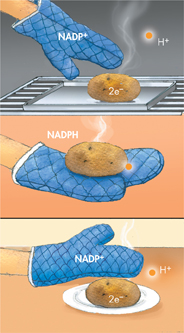High-Energy Electrons
 What are electron carrier molecules?
What are electron carrier molecules?
In a chemical sense, the high-energy electrons produced by chlorophyll are highly reactive and require a special “carrier.” Think of a high-energy electron as being similar to a hot potato straight from the oven. If you wanted to move the potato from one place to another, you wouldn't pick it up in your hands. You would use an oven mitt—a carrier—to transport it, as shown in Figure 8–6. Plant cells treat high-energy electrons in the same way. Instead of an oven mitt, however, they use electron carriers to transport high-energy electrons from chlorophyll to other molecules.  An electron carrier is a compound that can accept a pair of high-energy electrons and transfer them, along with most of their energy, to another molecule.
An electron carrier is a compound that can accept a pair of high-energy electrons and transfer them, along with most of their energy, to another molecule.
One of these carrier molecules is a compound known as NADP+ (nicotinamide adenine dinucleotide phosphate). The name is complicated, but the job that NADP+ has is simple. NADP+ accepts and holds 2 high-energy electrons, along with a hydrogen ion (H+). This converts the NADP+ into NADPH. The conversion of NADP+ into NADPH is one way in which some of the energy of sunlight can be trapped in chemical form. The NADPH can then carry the high-energy electrons that were produced by light absorption in chlorophyll to chemical reactions elsewhere in the cell. These high-energy electron carriers are used to help build a variety of molecules the cell needs, including carbohydrates like glucose.
VISUAL ANALOGY
CARRYING ELECTRONS

FIGURE 8–6 NADP+ is a carrier molecule that transports pairs of electrons (and an H+ ion) in photosynthetic organisms, similar to how an oven mitt is used to transport a hot object such as a baked potato.
An Overview of Photosynthesis
 What are the reactants and products of photosynthesis?
What are the reactants and products of photosynthesis?
Many steps are involved in the process of photosynthesis. However, the overall process of photosynthesis can be summarized in one sentence.  Photosynthesis uses the energy of sunlight to convert water and carbon dioxide (reactants) into high-energy sugars and oxygen (products). Plants then use the sugars to produce complex carbohydrates such as starches, and to provide energy for the synthesis of other compounds, including proteins and lipids.
Photosynthesis uses the energy of sunlight to convert water and carbon dioxide (reactants) into high-energy sugars and oxygen (products). Plants then use the sugars to produce complex carbohydrates such as starches, and to provide energy for the synthesis of other compounds, including proteins and lipids.
Because photosynthesis usually produces 6-carbon sugars (C6H12O6) as the final product, the overall reaction for photosynthesis can be shown as follows:

MYSTERY CLUE

Van Helmont concluded that water must have provided the extra mass gained by the tree. Further studies would prove that he had only half of the answer. What reactant involved in the photosynthesis equation was he not accounting for?

Table of Contents
- Formulas and Equations
- Applying Formulas and Equations
- Mean, Median, and Mode
- Estimation
- Using Measurements in Calculations
- Effects of Measurement Errors
- Accuracy
- Precision
- Comparing Accuracy and Precision
- Significant Figures
- Calculating With Significant Figures
- Scientific Notation
- Calculating With Scientific Notation
- Dimensional Analysis
- Applying Dimensional Analysis




